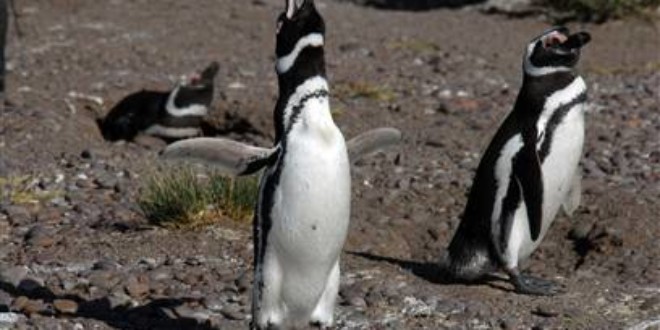Twelve of the world”s 17 species of penguins are seeing rapid population declines tied to overfishing, changing weather patterns and other factors, a leading expert warned Friday. P. Dee Boersma issued her warning at a presentation during the annual meeting of the American Association for the Advancement of Science, held this year in Chicago.
Boersma’s expertise is with Magellanic penguins, a small species that she has studied since 1982 from the southern waters of Argentina.
Penguin numbers at Argentina’s Punta Tombo colony have declined by more than 20 percent in the last 22 years, from 300,000 to just 200,000 breeding pairs, Boersma said.
Boersma, a University of Washington professor, recently published two papers documenting challenges faced by Magellanic penguins.
Penguins at Punta Tombo are traveling farther to find food than they did a decade ago, she found, due to changing ocean conditions and overfishing, especially of anchovies, a penguin staple.
That has forced some penguins to attempt to nest outside of protected areas where they often fall prey to predators.
“Penguins are having trouble with food on their wintering grounds and if that happens they’re not going to come back to their breeding grounds,” Boersma said in a statement issued by the Wildlife Conservation Society, which helps fund her work. “If we continue to fish down the food chain and take smaller and smaller fish like anchovies, there won’t be anything left for penguins and other wildlife that depend on these small fish for food.”
She also found that increased instances of heavy rains have caused high mortality of penguin chicks in five of the last 25 years.
“That turns their little nests into swimming pools,” she said.
Boersma noted that of 17 penguin species, 12 have seen rapid population declines.
Emperor, rockhopper concerns
Emperor penguins, the stars of the 2005 documentary “March of the Penguins,” could be headed toward extinction in at least part of their range before the end of the century, according to the study in the Proceedings of the National Academy of Sciences.
Using mathematical models, researchers found that if climate change continues to melt sea ice at the rates foreseen by the U.N. Intergovernmental Panel on Climate Change, the population of a large colony in Terre Adelie, Antarctica, likely will shrink from 3,000 breeding pairs to only 400 by 2100.
The probability of a drastic decline, by 95 percent or more, is at least 40 percent and perhaps as much as 80 percent, the researchers said, noting that such a decline would put the population at serious risk of extinction.
Sea ice provides a platform for penguins to breed, feed and molt, and a grazing ground for tiny krill, crustaceans that eat algae on the underside of the ice. Krill, in turn, are a food source for penguins and other marine animals.
One sea ice reduction in Terre Adelie during the 1970s led to a population decline of about 50 percent, the researchers noted.
A separate study found that the population of northern rockhoppers once reached into the millions, but now the largest colonies are estimated at between 32,000 to 65,000 pairs on Gough Island, and 40,000 to 50,000 pairs on Tristan da Cunha Island.
Possible factors, the researchers said, include climate change, shifts in marine ecosystems and overfishing.
U.S. likely to list several
The U.S. Fish and Wildlife Service is expected to soon list the African penguin as endangered under the Endangered Species Act, following a request made in 2006 by the Center for Biological Diversity that several species of penguin be listed.
A public comment period expires this month after the agency announced its proposal in mid-December.
The agency cited commercial fishing, prey declines, predation and oil pollution as threats.
It also proposes listing five species as threatened. Four are native to New Zealand: the yellow-eyed penguin; the white-flippered penguin; the Fiordland crested penguin; and the erect-crested penguin. The fifth species, the Humboldt penguin, is found in Chile and Peru.
(From msnbc.msn.com)
 Ocean Sentry
Ocean Sentry




